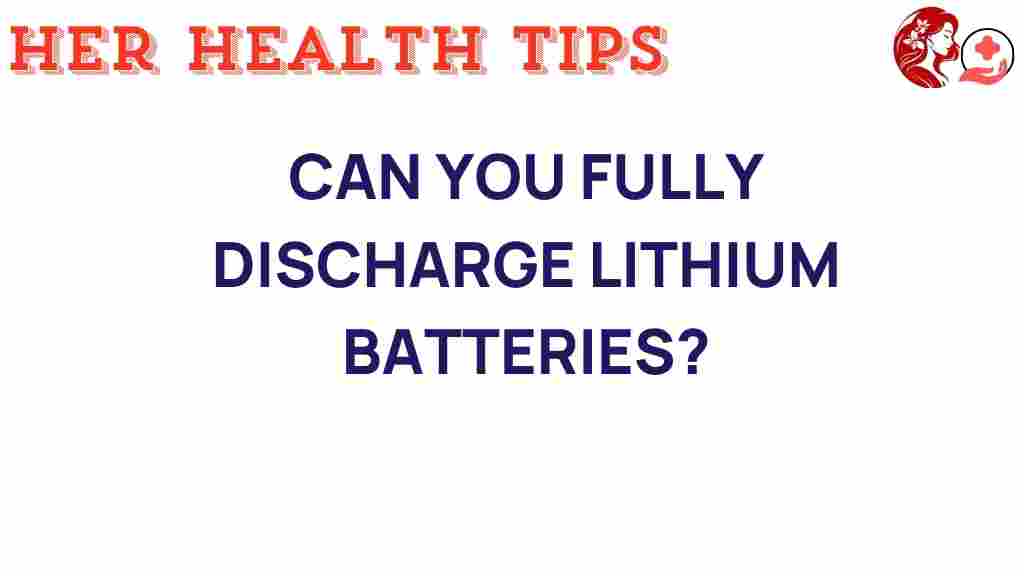The Truth About Lithium Batteries: Can They Be Fully Discharged?
Lithium batteries have become an integral part of our daily lives, powering everything from smartphones to electric vehicles. However, there’s a lot of confusion about their functionality, especially regarding battery discharge. Can lithium batteries be fully discharged? This article will delve into the nuances of lithium-ion technology, focusing on battery discharge, battery safety, and their impact on battery lifespan and the environment.
Understanding Lithium Batteries
Lithium batteries, particularly lithium-ion batteries, are a popular choice for rechargeable energy storage due to their high energy density and lightweight nature. These batteries are composed of lithium salts, which allow for efficient charging and discharging cycles. However, understanding their discharge characteristics is crucial for effective usage and longevity.
The Basics of Battery Discharge
Battery discharge refers to the process of releasing stored electrical energy from a battery. The rate and depth of battery discharge can significantly affect the overall performance and lifespan of lithium batteries. Here’s what you need to know:
- Depth of Discharge (DoD): This term describes how much energy is drawn from the battery compared to its total capacity. For lithium batteries, a lower DoD is preferable for longer lifespan.
- State of Charge (SoC): SoC indicates how much energy is left in the battery. Fully discharging a lithium battery can lead to a lower SoC, which can impact its performance.
Can Lithium Batteries Be Fully Discharged?
The short answer is: No, lithium batteries should not be fully discharged. Here’s why:
The Risks of Full Discharge
Fully discharging a lithium battery can lead to several issues:
- Battery Damage: When a lithium battery reaches a 0% state of charge, it can enter a state known as “deep discharge.” This can damage the battery’s internal structure, leading to irreversible capacity loss.
- Safety Risks: Deeply discharged lithium batteries can become unstable. In some cases, this can lead to safety hazards, including overheating or even fire.
- Reduced Lifespan: Regularly discharging a lithium battery to its limit can significantly shorten its lifespan, leading to the need for more frequent replacements.
Optimal Discharge Practices
To maintain the health of lithium batteries, it’s essential to adopt optimal discharge practices:
- Avoid Deep Discharge: Aim to keep the battery’s state of charge between 20% and 80% for optimal lifespan.
- Regular Charging: Regularly charge your devices to avoid reaching dangerously low battery levels.
- Use Battery Management Systems: Many modern devices come equipped with battery management systems (BMS) that prevent over-discharge and help maintain battery health.
Step-by-Step Guide to Proper Lithium Battery Maintenance
Maintaining lithium batteries involves a few key steps:
- Monitor Battery Levels: Use apps or built-in features to keep track of your battery’s state of charge.
- Charge Regularly: Plug in your device before it drops below 20% to avoid deep discharge.
- Store Properly: If storing batteries for an extended period, keep them at around 50% charge in a cool, dry place.
- Avoid Extreme Temperatures: High temperatures can cause battery damage, while low temperatures can reduce performance.
Troubleshooting Battery Issues
Even with proper care, you might encounter issues with your lithium batteries. Here are some common problems and their solutions:
Symptoms of Lithium Battery Problems
- Rapid Discharge: If your battery drains quickly, it might be time for a replacement.
- Overheating: If the battery gets excessively hot during use or charging, it could indicate a problem.
- Swelling: A swollen battery is a serious safety hazard and should be addressed immediately.
Solutions to Common Issues
- Calibrate the Battery: Occasionally, calibrating the battery can help improve its performance.
- Replace the Battery: If problems persist, consider replacing the battery with a new one.
- Consult a Professional: When in doubt, consult a technician to diagnose any underlying issues.
Environmental Impact of Lithium Batteries
While lithium batteries are a cornerstone of modern energy storage, they also raise environmental concerns. Here are some key points to consider:
Positive Aspects
- Energy Efficiency: Lithium-ion technology enables higher energy efficiency compared to traditional batteries.
- Recyclability: Many components of lithium batteries can be recycled, reducing waste.
Negative Aspects
- Resource Extraction: The mining of lithium can have detrimental effects on local ecosystems and communities.
- Disposal Issues: Improper disposal of lithium batteries can lead to environmental contamination.
To mitigate these impacts, it’s essential to recycle lithium batteries properly. For more information on how to recycle your batteries, visit EPA’s recycling guidelines.
Conclusion
In conclusion, lithium batteries are a powerful and efficient energy storage solution, but they require proper handling to maximize their lifespan and ensure safety. By avoiding full discharge, following optimal maintenance practices, and being aware of environmental impacts, you can enjoy the benefits of lithium-ion technology while minimizing risks. Remember, the longevity and safety of your rechargeable batteries depend on how well you manage their discharge and overall care. For more tips on battery maintenance, check out this comprehensive guide.
This article is in the category Prevention and created by HerHealthTips Team
